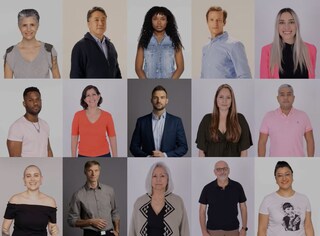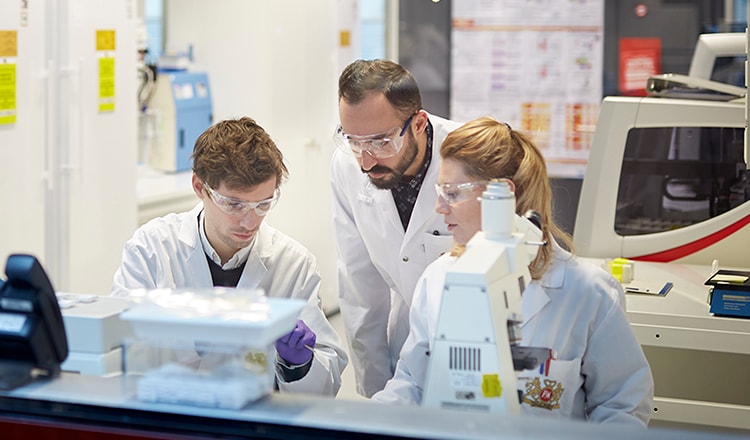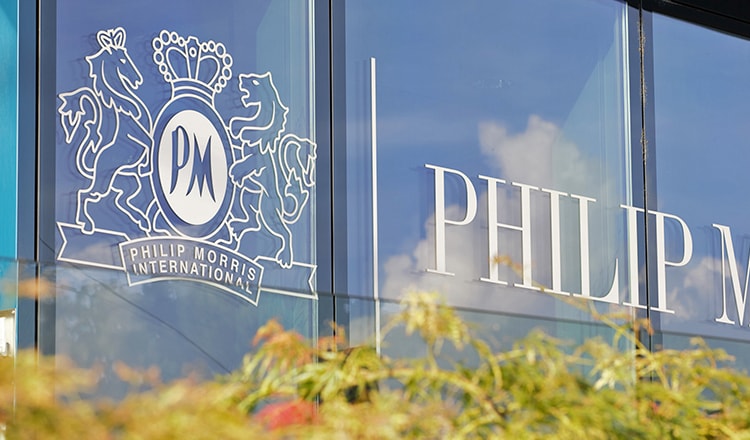Innovations to reduce the harm caused by certain behaviors and activities are woven into our everyday lives. PMI is calling for a similar approach to be applied to the known risks of smoking.
Find out how tobacco harm reduction could have a positive impact on the lives of adult smokers who don’t quit.

Smoke-free alternatives could deliver a 10-fold reduction in smoking-attributable deaths
Watch: Why tobacco harm reduction should be taken seriously

This is why tobacco harm reduction is critical
Instrumental music starts.
Moira Gilchrist, VP Strategic and Scientific Communications for Philip Morris International, speaks to camera:
The policy of harm reduction has been around forever.
How harm reduction can end smoking
Stacey Kennedy, President, Americas Region and CEO of PMI’s U.S. business, speaks to camera:
Harm reduction for me is all about looking at the types of harms that the human population endures and in looking at how consumers can replace more harmful behaviors with less harmful behaviors.
Gizelle Baker, Vice President Global Scientific Engagement for Philip Morris International, speaks to camera:
There is some level of inevitability that you won't be able to completely abolish or get rid of something that is negative to our health.
Gregoire Verdeaux, Senior Vice President, External Affairs, for Philip Morris International, speaks to camera:
Harm reduction is really one of the most exciting ways to look at policy and not only in the nicotine industry but for a number of industries.
Moira Gilchrist speaks to camera:
Whether it be automobiles or cars, we have seat belts, we have safety features like airbags and so on.
Jacek Olczak, CEO of Philip Morris International, speaks to camera:
Many years ago we discovered that part of the big contribution to energy saving could be switched to light bulbs which consume much less energy so we replace the old product with the better product.
Stefano Volpetti, President, Smoke-Free Inhaled Products and Chief Consumer Officer, speaks to camera:
Harm reduction might be a complex topic.
In reality, PMI’s philosophy makes it very clear:
If you don't smoke, don't start,
If you smoke, quit,
If you don't quit, change.
Stacey Kennedy speaks to camera:
If we just expect the 1 billion smokers on the planet to just stop, history over the past decades has told us that's simply not going to happen.
Lars Dahlgren, President, Smoke-free Oral Products & CEO, Swedish Match, speaks to camera:
The fact of the matter is that a lot of people don't quit tobacco because they enjoy their products, they enjoy nicotine.
Gregoire Verdeaux talks to camera:
For the people who do not regulate their own consumption, what can you do for them that is going to be acceptable?
Harm reduction means providing better alternatives.
Stacey Kennedy speaks to camera:
We really have to make sure that there is a broad societal awareness of the fact that burning tobacco is what causes the harm.
Bin Li, Chief Product Officer for Philip Morris International, speaks to camera:
We can deliver a product that can still give you a sensory and taste that's very close to tobacco and we have reduced the harm.
Stacey Kennedy speaks to camera:
It has to be a replacement product that satisfies consumers, that gives them a similar ritual, but that yet scientifically and technologically reduces the harm that they would otherwise be exposed to.
Gizelle Baker, speaks to camera:
Obviously there's still some level of toxicants that you're being exposed to when you switch to these products but it's significantly less than cigarette smoke.
Badrul Chowdhury, Chief Life Sciences Officer, Smoke-Free Products for Philip Morris International, speaks to camera:
You actually have a product where this 5,000, 6,000 chemicals are mostly eliminated and the 100 or so chemicals which are known to be harmful are reduced or eliminated.
Gizelle Baker, speaks to camera:
What we can say today is that millions of people who smoke cigarettes have given up cigarette smoking altogether to switch to these new products.
Gregoire Verdeaux talks to camera:
The end of cigarettes is doable.
Jacek Olczak speaks to camera:
The science exists.
The conversation should be what do we do now about the science?
Smoke-free products are not risk-free and provide nicotine, which is addictive.
Philip Morris International’s logo is seen on screen
Delivering a better, smoke-free future.
Music ends.

The Problem with Burning
Instrumental music starts.
Moira Gilchrist, VP Strategic and Scientific Communications for Philip Morris International, speaks to camera:
The policy of harm reduction has been around forever.
How harm reduction can end smoking
Stacey Kennedy, President, Americas Region and CEO of PMI’s U.S. business, speaks to camera:
Harm reduction for me is all about looking at the types of harms that the human population endures and in looking at how consumers can replace more harmful behaviors with less harmful behaviors.
Gizelle Baker, Vice President Global Scientific Engagement for Philip Morris International, speaks to camera:
There is some level of inevitability that you won't be able to completely abolish or get rid of something that is negative to our health.
Gregoire Verdeaux, Senior Vice President, External Affairs, for Philip Morris International, speaks to camera:
Harm reduction is really one of the most exciting ways to look at policy and not only in the nicotine industry but for a number of industries.
Moira Gilchrist speaks to camera:
Whether it be automobiles or cars, we have seat belts, we have safety features like airbags and so on.
Jacek Olczak, CEO of Philip Morris International, speaks to camera:
Many years ago we discovered that part of the big contribution to energy saving could be switched to light bulbs which consume much less energy so we replace the old product with the better product.
Stefano Volpetti, President, Smoke-Free Inhaled Products and Chief Consumer Officer, speaks to camera:
Harm reduction might be a complex topic.
In reality, PMI’s philosophy makes it very clear:
If you don't smoke, don't start,
If you smoke, quit,
If you don't quit, change.
Stacey Kennedy speaks to camera:
If we just expect the 1 billion smokers on the planet to just stop, history over the past decades has told us that's simply not going to happen.
Lars Dahlgren, President, Smoke-free Oral Products & CEO, Swedish Match, speaks to camera:
The fact of the matter is that a lot of people don't quit tobacco because they enjoy their products, they enjoy nicotine.
Gregoire Verdeaux talks to camera:
For the people who do not regulate their own consumption, what can you do for them that is going to be acceptable?
Harm reduction means providing better alternatives.
Stacey Kennedy speaks to camera:
We really have to make sure that there is a broad societal awareness of the fact that burning tobacco is what causes the harm.
Bin Li, Chief Product Officer for Philip Morris International, speaks to camera:
We can deliver a product that can still give you a sensory and taste that's very close to tobacco and we have reduced the harm.
Stacey Kennedy speaks to camera:
It has to be a replacement product that satisfies consumers, that gives them a similar ritual, but that yet scientifically and technologically reduces the harm that they would otherwise be exposed to.
Gizelle Baker, speaks to camera:
Obviously there's still some level of toxicants that you're being exposed to when you switch to these products but it's significantly less than cigarette smoke.
Badrul Chowdhury, Chief Life Sciences Officer, Smoke-Free Products for Philip Morris International, speaks to camera:
You actually have a product where this 5,000, 6,000 chemicals are mostly eliminated and the 100 or so chemicals which are known to be harmful are reduced or eliminated.
Gizelle Baker, speaks to camera:
What we can say today is that millions of people who smoke cigarettes have given up cigarette smoking altogether to switch to these new products.
Gregoire Verdeaux talks to camera:
The end of cigarettes is doable.
Jacek Olczak speaks to camera:
The science exists.
The conversation should be what do we do now about the science?
Smoke-free products are not risk-free and provide nicotine, which is addictive.
Philip Morris International’s logo is seen on screen
Delivering a better, smoke-free future.
Music ends.

Why We Need To Embrace Tobacco Harm Reduction
Instrumental music starts.
Moira Gilchrist, VP Strategic and Scientific Communications for Philip Morris International, speaks to camera:
The policy of harm reduction has been around forever.
How harm reduction can end smoking
Stacey Kennedy, President, Americas Region and CEO of PMI’s U.S. business, speaks to camera:
Harm reduction for me is all about looking at the types of harms that the human population endures and in looking at how consumers can replace more harmful behaviors with less harmful behaviors.
Gizelle Baker, Vice President Global Scientific Engagement for Philip Morris International, speaks to camera:
There is some level of inevitability that you won't be able to completely abolish or get rid of something that is negative to our health.
Gregoire Verdeaux, Senior Vice President, External Affairs, for Philip Morris International, speaks to camera:
Harm reduction is really one of the most exciting ways to look at policy and not only in the nicotine industry but for a number of industries.
Moira Gilchrist speaks to camera:
Whether it be automobiles or cars, we have seat belts, we have safety features like airbags and so on.
Jacek Olczak, CEO of Philip Morris International, speaks to camera:
Many years ago we discovered that part of the big contribution to energy saving could be switched to light bulbs which consume much less energy so we replace the old product with the better product.
Stefano Volpetti, President, Smoke-Free Inhaled Products and Chief Consumer Officer, speaks to camera:
Harm reduction might be a complex topic.
In reality, PMI’s philosophy makes it very clear:
If you don't smoke, don't start,
If you smoke, quit,
If you don't quit, change.
Stacey Kennedy speaks to camera:
If we just expect the 1 billion smokers on the planet to just stop, history over the past decades has told us that's simply not going to happen.
Lars Dahlgren, President, Smoke-free Oral Products & CEO, Swedish Match, speaks to camera:
The fact of the matter is that a lot of people don't quit tobacco because they enjoy their products, they enjoy nicotine.
Gregoire Verdeaux talks to camera:
For the people who do not regulate their own consumption, what can you do for them that is going to be acceptable?
Harm reduction means providing better alternatives.
Stacey Kennedy speaks to camera:
We really have to make sure that there is a broad societal awareness of the fact that burning tobacco is what causes the harm.
Bin Li, Chief Product Officer for Philip Morris International, speaks to camera:
We can deliver a product that can still give you a sensory and taste that's very close to tobacco and we have reduced the harm.
Stacey Kennedy speaks to camera:
It has to be a replacement product that satisfies consumers, that gives them a similar ritual, but that yet scientifically and technologically reduces the harm that they would otherwise be exposed to.
Gizelle Baker, speaks to camera:
Obviously there's still some level of toxicants that you're being exposed to when you switch to these products but it's significantly less than cigarette smoke.
Badrul Chowdhury, Chief Life Sciences Officer, Smoke-Free Products for Philip Morris International, speaks to camera:
You actually have a product where this 5,000, 6,000 chemicals are mostly eliminated and the 100 or so chemicals which are known to be harmful are reduced or eliminated.
Gizelle Baker, speaks to camera:
What we can say today is that millions of people who smoke cigarettes have given up cigarette smoking altogether to switch to these new products.
Gregoire Verdeaux talks to camera:
The end of cigarettes is doable.
Jacek Olczak speaks to camera:
The science exists.
The conversation should be what do we do now about the science?
Smoke-free products are not risk-free and provide nicotine, which is addictive.
Philip Morris International’s logo is seen on screen
Delivering a better, smoke-free future.
Music ends.

What is smoke?
Instrumental music starts.
Moira Gilchrist, VP Strategic and Scientific Communications for Philip Morris International, speaks to camera:
The policy of harm reduction has been around forever.
How harm reduction can end smoking
Stacey Kennedy, President, Americas Region and CEO of PMI’s U.S. business, speaks to camera:
Harm reduction for me is all about looking at the types of harms that the human population endures and in looking at how consumers can replace more harmful behaviors with less harmful behaviors.
Gizelle Baker, Vice President Global Scientific Engagement for Philip Morris International, speaks to camera:
There is some level of inevitability that you won't be able to completely abolish or get rid of something that is negative to our health.
Gregoire Verdeaux, Senior Vice President, External Affairs, for Philip Morris International, speaks to camera:
Harm reduction is really one of the most exciting ways to look at policy and not only in the nicotine industry but for a number of industries.
Moira Gilchrist speaks to camera:
Whether it be automobiles or cars, we have seat belts, we have safety features like airbags and so on.
Jacek Olczak, CEO of Philip Morris International, speaks to camera:
Many years ago we discovered that part of the big contribution to energy saving could be switched to light bulbs which consume much less energy so we replace the old product with the better product.
Stefano Volpetti, President, Smoke-Free Inhaled Products and Chief Consumer Officer, speaks to camera:
Harm reduction might be a complex topic.
In reality, PMI’s philosophy makes it very clear:
If you don't smoke, don't start,
If you smoke, quit,
If you don't quit, change.
Stacey Kennedy speaks to camera:
If we just expect the 1 billion smokers on the planet to just stop, history over the past decades has told us that's simply not going to happen.
Lars Dahlgren, President, Smoke-free Oral Products & CEO, Swedish Match, speaks to camera:
The fact of the matter is that a lot of people don't quit tobacco because they enjoy their products, they enjoy nicotine.
Gregoire Verdeaux talks to camera:
For the people who do not regulate their own consumption, what can you do for them that is going to be acceptable?
Harm reduction means providing better alternatives.
Stacey Kennedy speaks to camera:
We really have to make sure that there is a broad societal awareness of the fact that burning tobacco is what causes the harm.
Bin Li, Chief Product Officer for Philip Morris International, speaks to camera:
We can deliver a product that can still give you a sensory and taste that's very close to tobacco and we have reduced the harm.
Stacey Kennedy speaks to camera:
It has to be a replacement product that satisfies consumers, that gives them a similar ritual, but that yet scientifically and technologically reduces the harm that they would otherwise be exposed to.
Gizelle Baker, speaks to camera:
Obviously there's still some level of toxicants that you're being exposed to when you switch to these products but it's significantly less than cigarette smoke.
Badrul Chowdhury, Chief Life Sciences Officer, Smoke-Free Products for Philip Morris International, speaks to camera:
You actually have a product where this 5,000, 6,000 chemicals are mostly eliminated and the 100 or so chemicals which are known to be harmful are reduced or eliminated.
Gizelle Baker, speaks to camera:
What we can say today is that millions of people who smoke cigarettes have given up cigarette smoking altogether to switch to these new products.
Gregoire Verdeaux talks to camera:
The end of cigarettes is doable.
Jacek Olczak speaks to camera:
The science exists.
The conversation should be what do we do now about the science?
Smoke-free products are not risk-free and provide nicotine, which is addictive.
Philip Morris International’s logo is seen on screen
Delivering a better, smoke-free future.
Music ends.

This is why tobacco harm reduction is critical
Instrumental music starts.
Moira Gilchrist, VP Strategic and Scientific Communications for Philip Morris International, speaks to camera:
The policy of harm reduction has been around forever.
How harm reduction can end smoking
Stacey Kennedy, President, Americas Region and CEO of PMI’s U.S. business, speaks to camera:
Harm reduction for me is all about looking at the types of harms that the human population endures and in looking at how consumers can replace more harmful behaviors with less harmful behaviors.
Gizelle Baker, Vice President Global Scientific Engagement for Philip Morris International, speaks to camera:
There is some level of inevitability that you won't be able to completely abolish or get rid of something that is negative to our health.
Gregoire Verdeaux, Senior Vice President, External Affairs, for Philip Morris International, speaks to camera:
Harm reduction is really one of the most exciting ways to look at policy and not only in the nicotine industry but for a number of industries.
Moira Gilchrist speaks to camera:
Whether it be automobiles or cars, we have seat belts, we have safety features like airbags and so on.
Jacek Olczak, CEO of Philip Morris International, speaks to camera:
Many years ago we discovered that part of the big contribution to energy saving could be switched to light bulbs which consume much less energy so we replace the old product with the better product.
Stefano Volpetti, President, Smoke-Free Inhaled Products and Chief Consumer Officer, speaks to camera:
Harm reduction might be a complex topic.
In reality, PMI’s philosophy makes it very clear:
If you don't smoke, don't start,
If you smoke, quit,
If you don't quit, change.
Stacey Kennedy speaks to camera:
If we just expect the 1 billion smokers on the planet to just stop, history over the past decades has told us that's simply not going to happen.
Lars Dahlgren, President, Smoke-free Oral Products & CEO, Swedish Match, speaks to camera:
The fact of the matter is that a lot of people don't quit tobacco because they enjoy their products, they enjoy nicotine.
Gregoire Verdeaux talks to camera:
For the people who do not regulate their own consumption, what can you do for them that is going to be acceptable?
Harm reduction means providing better alternatives.
Stacey Kennedy speaks to camera:
We really have to make sure that there is a broad societal awareness of the fact that burning tobacco is what causes the harm.
Bin Li, Chief Product Officer for Philip Morris International, speaks to camera:
We can deliver a product that can still give you a sensory and taste that's very close to tobacco and we have reduced the harm.
Stacey Kennedy speaks to camera:
It has to be a replacement product that satisfies consumers, that gives them a similar ritual, but that yet scientifically and technologically reduces the harm that they would otherwise be exposed to.
Gizelle Baker, speaks to camera:
Obviously there's still some level of toxicants that you're being exposed to when you switch to these products but it's significantly less than cigarette smoke.
Badrul Chowdhury, Chief Life Sciences Officer, Smoke-Free Products for Philip Morris International, speaks to camera:
You actually have a product where this 5,000, 6,000 chemicals are mostly eliminated and the 100 or so chemicals which are known to be harmful are reduced or eliminated.
Gizelle Baker, speaks to camera:
What we can say today is that millions of people who smoke cigarettes have given up cigarette smoking altogether to switch to these new products.
Gregoire Verdeaux talks to camera:
The end of cigarettes is doable.
Jacek Olczak speaks to camera:
The science exists.
The conversation should be what do we do now about the science?
Smoke-free products are not risk-free and provide nicotine, which is addictive.
Philip Morris International’s logo is seen on screen
Delivering a better, smoke-free future.
Music ends.

The Problem with Burning
Instrumental music starts.
Moira Gilchrist, VP Strategic and Scientific Communications for Philip Morris International, speaks to camera:
The policy of harm reduction has been around forever.
How harm reduction can end smoking
Stacey Kennedy, President, Americas Region and CEO of PMI’s U.S. business, speaks to camera:
Harm reduction for me is all about looking at the types of harms that the human population endures and in looking at how consumers can replace more harmful behaviors with less harmful behaviors.
Gizelle Baker, Vice President Global Scientific Engagement for Philip Morris International, speaks to camera:
There is some level of inevitability that you won't be able to completely abolish or get rid of something that is negative to our health.
Gregoire Verdeaux, Senior Vice President, External Affairs, for Philip Morris International, speaks to camera:
Harm reduction is really one of the most exciting ways to look at policy and not only in the nicotine industry but for a number of industries.
Moira Gilchrist speaks to camera:
Whether it be automobiles or cars, we have seat belts, we have safety features like airbags and so on.
Jacek Olczak, CEO of Philip Morris International, speaks to camera:
Many years ago we discovered that part of the big contribution to energy saving could be switched to light bulbs which consume much less energy so we replace the old product with the better product.
Stefano Volpetti, President, Smoke-Free Inhaled Products and Chief Consumer Officer, speaks to camera:
Harm reduction might be a complex topic.
In reality, PMI’s philosophy makes it very clear:
If you don't smoke, don't start,
If you smoke, quit,
If you don't quit, change.
Stacey Kennedy speaks to camera:
If we just expect the 1 billion smokers on the planet to just stop, history over the past decades has told us that's simply not going to happen.
Lars Dahlgren, President, Smoke-free Oral Products & CEO, Swedish Match, speaks to camera:
The fact of the matter is that a lot of people don't quit tobacco because they enjoy their products, they enjoy nicotine.
Gregoire Verdeaux talks to camera:
For the people who do not regulate their own consumption, what can you do for them that is going to be acceptable?
Harm reduction means providing better alternatives.
Stacey Kennedy speaks to camera:
We really have to make sure that there is a broad societal awareness of the fact that burning tobacco is what causes the harm.
Bin Li, Chief Product Officer for Philip Morris International, speaks to camera:
We can deliver a product that can still give you a sensory and taste that's very close to tobacco and we have reduced the harm.
Stacey Kennedy speaks to camera:
It has to be a replacement product that satisfies consumers, that gives them a similar ritual, but that yet scientifically and technologically reduces the harm that they would otherwise be exposed to.
Gizelle Baker, speaks to camera:
Obviously there's still some level of toxicants that you're being exposed to when you switch to these products but it's significantly less than cigarette smoke.
Badrul Chowdhury, Chief Life Sciences Officer, Smoke-Free Products for Philip Morris International, speaks to camera:
You actually have a product where this 5,000, 6,000 chemicals are mostly eliminated and the 100 or so chemicals which are known to be harmful are reduced or eliminated.
Gizelle Baker, speaks to camera:
What we can say today is that millions of people who smoke cigarettes have given up cigarette smoking altogether to switch to these new products.
Gregoire Verdeaux talks to camera:
The end of cigarettes is doable.
Jacek Olczak speaks to camera:
The science exists.
The conversation should be what do we do now about the science?
Smoke-free products are not risk-free and provide nicotine, which is addictive.
Philip Morris International’s logo is seen on screen
Delivering a better, smoke-free future.
Music ends.

Why We Need To Embrace Tobacco Harm Reduction
Instrumental music starts.
Moira Gilchrist, VP Strategic and Scientific Communications for Philip Morris International, speaks to camera:
The policy of harm reduction has been around forever.
How harm reduction can end smoking
Stacey Kennedy, President, Americas Region and CEO of PMI’s U.S. business, speaks to camera:
Harm reduction for me is all about looking at the types of harms that the human population endures and in looking at how consumers can replace more harmful behaviors with less harmful behaviors.
Gizelle Baker, Vice President Global Scientific Engagement for Philip Morris International, speaks to camera:
There is some level of inevitability that you won't be able to completely abolish or get rid of something that is negative to our health.
Gregoire Verdeaux, Senior Vice President, External Affairs, for Philip Morris International, speaks to camera:
Harm reduction is really one of the most exciting ways to look at policy and not only in the nicotine industry but for a number of industries.
Moira Gilchrist speaks to camera:
Whether it be automobiles or cars, we have seat belts, we have safety features like airbags and so on.
Jacek Olczak, CEO of Philip Morris International, speaks to camera:
Many years ago we discovered that part of the big contribution to energy saving could be switched to light bulbs which consume much less energy so we replace the old product with the better product.
Stefano Volpetti, President, Smoke-Free Inhaled Products and Chief Consumer Officer, speaks to camera:
Harm reduction might be a complex topic.
In reality, PMI’s philosophy makes it very clear:
If you don't smoke, don't start,
If you smoke, quit,
If you don't quit, change.
Stacey Kennedy speaks to camera:
If we just expect the 1 billion smokers on the planet to just stop, history over the past decades has told us that's simply not going to happen.
Lars Dahlgren, President, Smoke-free Oral Products & CEO, Swedish Match, speaks to camera:
The fact of the matter is that a lot of people don't quit tobacco because they enjoy their products, they enjoy nicotine.
Gregoire Verdeaux talks to camera:
For the people who do not regulate their own consumption, what can you do for them that is going to be acceptable?
Harm reduction means providing better alternatives.
Stacey Kennedy speaks to camera:
We really have to make sure that there is a broad societal awareness of the fact that burning tobacco is what causes the harm.
Bin Li, Chief Product Officer for Philip Morris International, speaks to camera:
We can deliver a product that can still give you a sensory and taste that's very close to tobacco and we have reduced the harm.
Stacey Kennedy speaks to camera:
It has to be a replacement product that satisfies consumers, that gives them a similar ritual, but that yet scientifically and technologically reduces the harm that they would otherwise be exposed to.
Gizelle Baker, speaks to camera:
Obviously there's still some level of toxicants that you're being exposed to when you switch to these products but it's significantly less than cigarette smoke.
Badrul Chowdhury, Chief Life Sciences Officer, Smoke-Free Products for Philip Morris International, speaks to camera:
You actually have a product where this 5,000, 6,000 chemicals are mostly eliminated and the 100 or so chemicals which are known to be harmful are reduced or eliminated.
Gizelle Baker, speaks to camera:
What we can say today is that millions of people who smoke cigarettes have given up cigarette smoking altogether to switch to these new products.
Gregoire Verdeaux talks to camera:
The end of cigarettes is doable.
Jacek Olczak speaks to camera:
The science exists.
The conversation should be what do we do now about the science?
Smoke-free products are not risk-free and provide nicotine, which is addictive.
Philip Morris International’s logo is seen on screen
Delivering a better, smoke-free future.
Music ends.

What is smoke?
Instrumental music starts.
Moira Gilchrist, VP Strategic and Scientific Communications for Philip Morris International, speaks to camera:
The policy of harm reduction has been around forever.
How harm reduction can end smoking
Stacey Kennedy, President, Americas Region and CEO of PMI’s U.S. business, speaks to camera:
Harm reduction for me is all about looking at the types of harms that the human population endures and in looking at how consumers can replace more harmful behaviors with less harmful behaviors.
Gizelle Baker, Vice President Global Scientific Engagement for Philip Morris International, speaks to camera:
There is some level of inevitability that you won't be able to completely abolish or get rid of something that is negative to our health.
Gregoire Verdeaux, Senior Vice President, External Affairs, for Philip Morris International, speaks to camera:
Harm reduction is really one of the most exciting ways to look at policy and not only in the nicotine industry but for a number of industries.
Moira Gilchrist speaks to camera:
Whether it be automobiles or cars, we have seat belts, we have safety features like airbags and so on.
Jacek Olczak, CEO of Philip Morris International, speaks to camera:
Many years ago we discovered that part of the big contribution to energy saving could be switched to light bulbs which consume much less energy so we replace the old product with the better product.
Stefano Volpetti, President, Smoke-Free Inhaled Products and Chief Consumer Officer, speaks to camera:
Harm reduction might be a complex topic.
In reality, PMI’s philosophy makes it very clear:
If you don't smoke, don't start,
If you smoke, quit,
If you don't quit, change.
Stacey Kennedy speaks to camera:
If we just expect the 1 billion smokers on the planet to just stop, history over the past decades has told us that's simply not going to happen.
Lars Dahlgren, President, Smoke-free Oral Products & CEO, Swedish Match, speaks to camera:
The fact of the matter is that a lot of people don't quit tobacco because they enjoy their products, they enjoy nicotine.
Gregoire Verdeaux talks to camera:
For the people who do not regulate their own consumption, what can you do for them that is going to be acceptable?
Harm reduction means providing better alternatives.
Stacey Kennedy speaks to camera:
We really have to make sure that there is a broad societal awareness of the fact that burning tobacco is what causes the harm.
Bin Li, Chief Product Officer for Philip Morris International, speaks to camera:
We can deliver a product that can still give you a sensory and taste that's very close to tobacco and we have reduced the harm.
Stacey Kennedy speaks to camera:
It has to be a replacement product that satisfies consumers, that gives them a similar ritual, but that yet scientifically and technologically reduces the harm that they would otherwise be exposed to.
Gizelle Baker, speaks to camera:
Obviously there's still some level of toxicants that you're being exposed to when you switch to these products but it's significantly less than cigarette smoke.
Badrul Chowdhury, Chief Life Sciences Officer, Smoke-Free Products for Philip Morris International, speaks to camera:
You actually have a product where this 5,000, 6,000 chemicals are mostly eliminated and the 100 or so chemicals which are known to be harmful are reduced or eliminated.
Gizelle Baker, speaks to camera:
What we can say today is that millions of people who smoke cigarettes have given up cigarette smoking altogether to switch to these new products.
Gregoire Verdeaux talks to camera:
The end of cigarettes is doable.
Jacek Olczak speaks to camera:
The science exists.
The conversation should be what do we do now about the science?
Smoke-free products are not risk-free and provide nicotine, which is addictive.
Philip Morris International’s logo is seen on screen
Delivering a better, smoke-free future.
Music ends.
There’s no doubt that the best choice for all those who smoke is to quit tobacco and nicotine completely. But we know that many adults won’t quit, and these people deserve access to better alternatives to continued smoking. These innovations exist and are driving real change.












